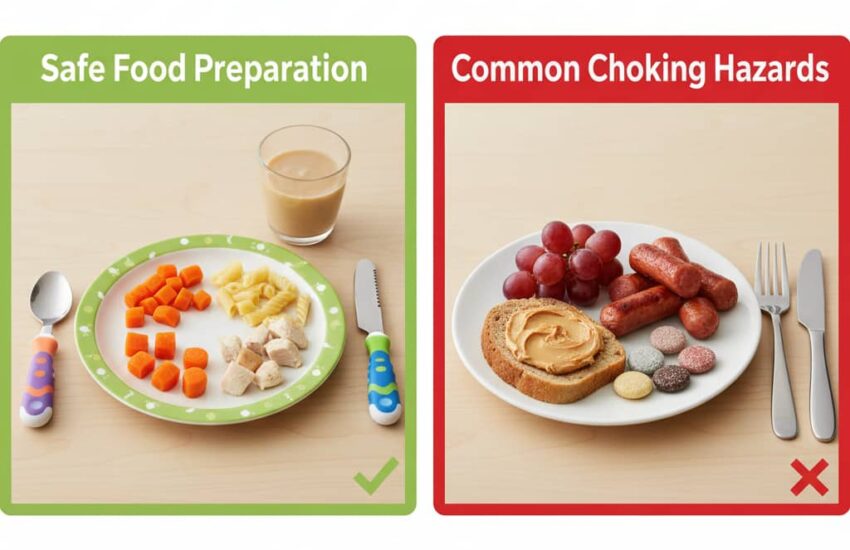Choking is a leading cause of injury and death among seniors. Learn to identify hidden risks and implement simple strategies to create safer eating environments at home and in care facilities. The sound is one you never forget, the desperate, silent struggle for air that replaces ordinary mealtime conversation. I first heard it during a family dinner at my grandmother’s nursing home, when a normally cheerful resident suddenly clutched her throat, her eyes wide with panic. Quick action by a staff member prevented a tragedy that day, but the incident revealed how something as fundamental as eating can become dangerously complicated with age. That moment began my journey into understanding choking prevention, moving from fear to practical empowerment.
Choking represents a particularly insidious risk for seniors because it strikes during what should be a pleasurable, social activity. The statistics are sobering; adults over 65 face a seven times higher risk of choking fatalities than younger adults. This vulnerability stems from natural age-related changes: reduced saliva production, weakened swallowing muscles, and delayed reflexes that can allow food to enter the airway before the body signals danger. What makes this especially challenging is that many seniors hide swallowing difficulties, fearing the loss of independence or being transitioned to pureed diets.
The most common choking hazards often hide in plain sight. Foods we consider everyday staples can become dangerous for someone with compromised swallowing. Grapes, if served whole, perfectly conform to the airway. Hot dogs and sausages have a dangerous combination of slippery surface and firm texture. Even seemingly soft foods like white bread can form a dense paste that’s difficult to clear. I’ve watched facility kitchens transform meal service by simply quartering grapes lengthwise, cutting hot dogs into small pieces rather than round slices, and toasting bread lightly to reduce its gummy texture.
The preparation method often matters more than the food itself. Moist, tender meats are safer than dry, fibrous ones. Steamed vegetables retain more moisture than roasted ones. Adding sauces or gravies can significantly reduce risk by providing additional lubrication. One care home dramatically reduced choking incidents by switching from serving plain chicken breast to serving chicken in a light cream sauce and shredding it before serving. These subtle modifications preserve dining pleasure while dramatically improving safety.
Environmental factors significantly influence choking risk. Distractions like television or loud conversations can divert attention from the careful process of chewing and swallowing. I’ve observed residents in facilities with dining rooms specifically designed for focus, with adequate lighting, minimal noise, and staff trained to recognize when someone needs quiet concentration during meals. The simple act of reminding residents to “focus on your food” before turning to conversation has prevented countless potential incidents.
Dental health plays an unexpectedly crucial role. Ill-fitting dentures, missing teeth, or oral pain can prevent proper chewing, causing seniors to swallow larger pieces than they can safely manage. Regular dental check-ups and ensuring dentures fit properly are not just matters of comfort but of safety. I worked with one family who discovered their father’s repeated near-choking episodes stopped completely after he received properly fitted dentures that allowed him to chew effectively.
Medication side effects create hidden vulnerabilities. Many common medications cause dry mouth, reducing the natural lubrication needed for safe swallowing. Diuretics, antidepressants, and antihistamines are frequent culprits. When my own mother began choking more frequently, we traced it to a new blood pressure medication. Her doctor prescribed a saliva substitute, and the problem resolved, a simple solution that addressed the root cause rather than just the symptom.

The posture and position during eating make a profound difference. Sitting fully upright with feet flat on the floor aligns the airway properly for swallowing. Leaning forward slightly, known as the “chin tuck” maneuver, can protect the airway for those with specific swallowing difficulties. I’ve seen facilities implement simple posture checks before meals, ensuring residents are fully awake, alert, and positioned correctly, with remarkable results in reducing incidents.
Recognizing the signs of swallowing difficulty requires vigilance. Coughing or throat clearing during meals, a gurgly voice after eating, frequent pneumonia, or unexplained weight loss can all indicate silent aspiration, when food or liquid enters the airway without triggering a cough reflex. These subtle signs often precede a major choking incident, providing crucial opportunities for intervention.
Specialized utensils and dishware can bridge the gap between independence and safety. Weighted utensils help steady trembling hands, while partitioned plates prevent foods from mixing into dangerous combinations. One family found their father’s choking incidents decreased when they switched from a regular glass to a special cup that controlled the flow rate, preventing him from taking too large a sip.
The social and psychological dimensions of choking risk require sensitive handling. No one wants to be served child-like foods or have their eating constantly monitored. The most effective approaches preserve dignity while managing risk. I’ve seen creative chefs in care facilities transform modified diets into appealing presentations, turning pureed meals into elegant terrine shapes and using natural thickeners to create soups that are both safe and delicious.
Emergency preparedness remains essential despite prevention efforts. Staff and family members should learn the Heimlich maneuver specifically adapted for seniors, being mindful of fragile bones and medical devices. I encourage facilities to conduct regular drills because when choking occurs, seconds count, and muscle memory matters more than frantic recall.
What began as a frightening incident in a dining room evolved into a recognition that safe eating requires addressing physical, environmental, and social factors simultaneously. The goal isn’t to eliminate risk entirely but to manage it intelligently—preserving the real pleasure of meals while protecting against their potential danger. By understanding the unique vulnerabilities seniors face and implementing thoughtful, multi-layered strategies, we can transform mealtimes from moments of anxiety back into the social, nourishing experiences they should be.
References
CE Safety. (2025, June 15). Report: Revealing the level of UK choking deaths. Retrieved from https://cesafety.co.uk/news/report-the-un-usual-suspects-main-causes-of-choking-deaths-in-the-uk/
This report analyzes UK data from 2018-2022, highlighting that seniors over 65 account for 90% of food-related choking deaths, primarily occurring in hospitals, care homes, and residences, with risks exacerbated by reduced saliva, poor dentition, and swallowing difficulties.
Quilter, D. (n.d.). Avoiding choking hazards in the elderly. Retrieved from https://www.cdss.ca.gov/agedblinddisabled/res/VPTC2/9%20Food%20Nutrition%20and%20Preparation/Avoiding_Choking_Hazards_in_the_Elderly.pdf
Offers practical advice on foods and behaviors to avoid in elders to reduce choking risk, noting factors like reduced saliva production, slow chewing, and improper use of dentures.
Saccomanno, S. (2023, October 26). Risk factors and prevention of choking. *PMC*. Retrieved from https://pmc.ncbi.nlm.nih.gov/articles/PMC10811631/
Details medical and neurological risk factors for choking and emphasizes prevention approaches, including proper chewing, supervision during meals, and emergency response knowledge, like the Heimlich maneuver.
Kramarow, E. (2014, June 20). Food-related choking deaths among the elderly. *PubMed.* Retrieved from https://pubmed.ncbi.nlm.nih.gov/24003082/
Documents thousands of choking deaths annually in older adults in the U.S., emphasizing the need for awareness and preventive care strategies.
Right at Home. (n.d.). Choking risks for older adults: What you need to know. Retrieved from https://www.rightathome.net/blog/choking-risks-high-for-seniors

